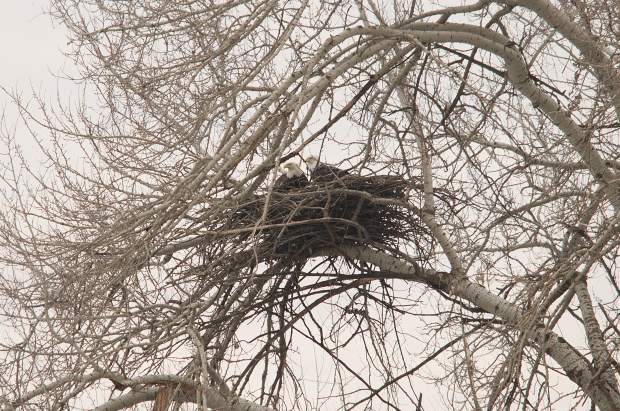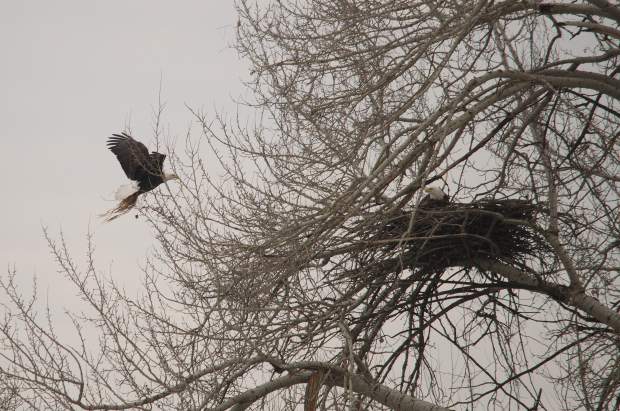Grab your binoculars and a snug jacket. The climate is ripe for avian celebrity sightings.
As cold weather starts to set in, frozen streams and rivers up north send bald eagles — now the country’s official national bird — in search of open water in which to hunt. With its many rivers, Illinois is a popular wintering spot for the migratory birds, including the waterways that cross DuPage and Will counties.
Not sure where to start? Local forest preserve districts have you covered.
Jan. 11 marks the Forest Preserve District of Will County’s 2025 Eagle Watch event, an annual celebration that offers attendees an opportune chance to spot the large raptors. It will be held at Four Rivers Environmental Education Center in Channahon from 11 a.m. to 3 p.m.
Beyond eagle-watching, the event will feature live bird presentations, crafts, a scavenger hunt and guided hikes. But bald eagles, really, are the stars of the show. And what better stage than the district’s Channahon center, which is located where the DuPage, Kankakee and Des Plaines rivers converge to form the Illinois River. It’s open water galore.
“People often dread cooler weather at this time of year, but freezing temperatures bring bald eagles in large numbers to the water around Four Rivers,” Jess McQuown, a program coordinator at Four Rivers, said in a news release.
Every year from December through March, about 3,100 bald eagles will travel to Illinois to spend the winter before migrating back north, the Illinois Department of Natural Resources estimates.
Apart from the Four Rivers center, other areas around Will County where bald eagles are likely to be found include the Lake Renwick Preserve in Plainfield, Rock Run Rookery Preserve in Joliet and Whalon Lake in Naperville, according to its forest preserve district.
All along the Fox River in Kane County is also a good bet, said Glenn Perricone, an environmental interpreter with the Forest Preserve District of DuPage County.
In DuPage, Perricone recommended Waterfall Glen Forest Preserve in Lemont. In fact, there’s already been “quite a few eagle sightings” there this winter, Perricone said.
“That’s probably been the most active area this winter for bald eagles,” he noted.
There have been sightings along the western branch of the DuPage River, especially at McKee Marsh at Blackwell Forest Preserve in Warrenville, Perricone said.
Mike Warner, longtime member of the DuPage Birding Club, spotted a bald eagle on New Year’s Day at Morton Arboretum. He and about 30 other club members had been on a bird watch when they saw it flying over the Lisle botanical garden, he said.
Warner has long had an interest in birds but when he retired 12 years ago, birdwatching became a passion for he and his wife, he said. Together, they regularly go out looking for birds throughout DuPage County, Illinois and wherever else can. This month, the pastime is taking them to Ecuador.
Warner’s favorite part about the hobby is capturing what his bird-finds look like through the lens of his camera, he said. He likes photographing the birds mid-flight, especially bald eagles.
Though January and February have historically been the prime eagle viewing time for bald eagles in Illinois, don’t fret if you don’t spot one over the next few weeks. There are opportunities year-round thanks to bald eagles that have started to make local forest preserves their full-time homes in recent years.
Nowadays, they are “a lot more like frequents in our area,” Perricone said. That’s the result of the birds “probably being one of the best conservation stories in our nation,” he said.
Once in danger of extinction after facing habitat destruction and degradation, illegal shooting and pesticide contamination of its food sources, bald eagles have been on the rebound for the past 50 years, according to the U.S. Fish & Wildlife Service.
The pesticide DDT was banned in 1972. A year later, the Endangered Species Act was enacted. Bald eagles were listed as endangered or threatened throughout the lower 48 states. The raptors were bred in captivity and reintroduced to the wild. Nesting sites were protected.
By 2007, there were nearly 10,000 nesting pairs of bald eagles in the contiguous U.S., which allowed them to be removed from the threatened and endangered list.
The first time the Forest Preserve District of Will County found a nest on preserve property was in 2018, according to Joel Craig, a volunteer who monitors eagles for the district. By last year, the district had four active nests.
“Eagles are thriving,” Craig said, “and we’ve seen the number grow in the past 10 years or so, especially locally.”
All four nests — which are located in Plainfield, Shorewood, Romeoville and Lockport — each produced two eggs last year. The eaglets hatched in March. Then, about 12 weeks after, they fledged, which means they took their first flight away from the nest.

Coming off a fruitful year for its resident eagle population, the district is once again on the lookout for new nests that may appear. Late January and early February is when the courtship and nest building period takes place in the Midwest, according to the district. Egg laying typically begins at the end of February.
As of Thursday, there hadn’t been any reports of new nests being built yet, but this “is exactly the time of year when that would happen,” Craig said.
Should you venture out to spot some eagles this winter — or anytime — Forest Preserve District of Will County officials remind birdwatchers to keep their distance. Eagles are especially sensitive to human activity when they are courting and building nests.
Chicago Tribune reporter Peter Breen contributed.




